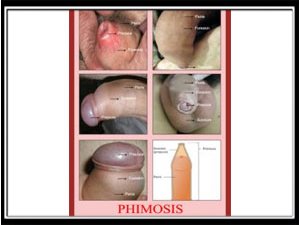Phimosis
What is Phimosis?
Phimosis describes a condition in which the foreskin is too tight to be pulled back over the head or glans of the penis.
In adults, there are a number of risk factors and causes of phimosis, though it only tends to be a problem if it causes symptoms.
Causes and risk factors
It is most likely to occur in Adult boys with:
- Repeated urinary tract infections
- Foreskin infection
- Repeated rough handling of the foreskin
- Foreskin trauma
- By Birth.
In adults, risk factors for phimosis include sexually transmitted infections
Phimosis may be caused by a skin condition, such as:
- Eczema: A long-term condition that causes the skin to become itchy, red, dry, and cracked.
- Psoriasis: This skin condition leads to patches of skin becoming red, flaky, and crusty.
- Lichen planus: An itchy rash that can affect different areas of the body. It is not contagious.
- Lichen sclerosus: This condition causes scarring on the foreskin that can lead to phimosis. It may be caused by a urinary irritation
Symptoms
Phimosis does not always lead to symptoms. When it does, however, these may include redness, soreness, or swelling.
A tight foreskin may interfere with the normal passage of urine. In severe cases, this can prevent the person from emptying their bladder fully.
Many times while passing the urine, there is ballooning of prepuce / foreskin occurs.
Urine is passed in a very thin stream & takes a lot of time to evacuate the whole bladder.
During sex, phimosis causes severe pain & skin splitting (Rupturing). Wearing a condom and using lubricant can make intercourse more comfortable.
Phimosis can also lead to inflammation of the penis, called balanitis, or inflammation of both the glans and the foreskin, called balanoposthitis. These conditions both tend to be caused by poor hygiene.
Symptoms of balanitis include:
- soreness, itchiness, and odor
- redness and swelling
- a buildup of thick fluid
- pain when urinating
Diagnosis
A doctor will take a full history from the person, asking about any previous penis infection or injuries they might have had. They may also inquire about the impact of any symptoms on sexual activity. A physical examination will include them looking at the penis and foreskin.
The Best Sex Doctor in Indiamay order urine tests to check for urine infections or take a swab from the foreskin area to check for bacteria.
Phimosis is a risk factor for type 2 diabetes. Adults presenting with a tight foreskin may be given blood and urine tests to check their blood sugar levels, as a result.
Treatment by Best Sex Doctor in India
Treatment options for phimosis depend on the symptoms that occur recommended by our Best Sex Doctor in India. Most cases of balanitis are easily treated with good hygiene, creams, and ointments.
People are advised to clean the penis daily with lukewarm water and to dry it gently to improve hygiene. They should avoid using soap, bubble bath or shampoo on their genitals, and dry under the foreskin after urinating.
A doctor may recommend using a steroid cream or ointment to help with the irritation.
If balanoposthitis has been caused by a fungal or bacterial infection, an antifungal cream or a course of antibiotics may be needed.
Doctors may suggest circumcision, in which all or part of the foreskin is removed.
If you are looking for ayurvedic treatment from the best sex doctor in Mumbai (India), It is best done by us – Kayakalp international clinics in Mumbai.







